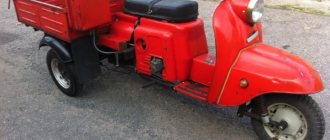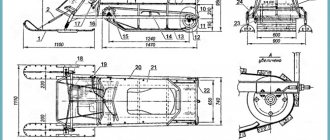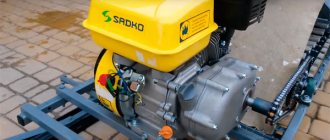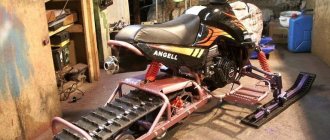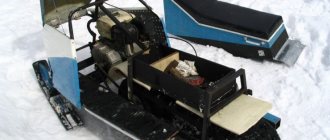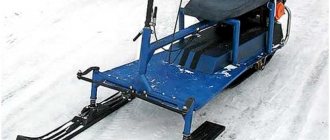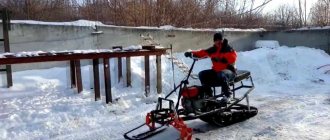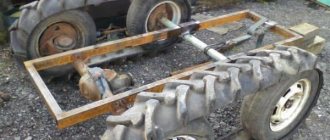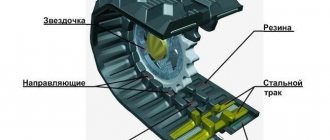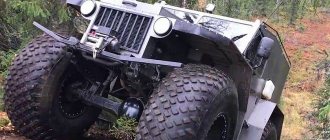A homemade snowmobile from an IZH motorcycle or any other is not as difficult as it might seem. Moreover, when winter comes, you can’t ride a regular motorcycle very much, so you have to make a homemade snowmobile from a motorcycle.
To make it comfortable to ride on winter roads, you need to re-equip the motorcycle, install a side trailer and change the front wheel so that it has a deeper tread.
Only a snowmobile can drive on snow-covered roads; not even cars can drive through serious snowdrifts. For those who can, it’s better to buy a snowmobile and not worry, but for those who don’t have money or want to make something useful and original themselves, you can make a homemade snowmobile from a motorcycle.
No one will convert a modern sportsbike or tourist motorcycle, but an old IZH or any other rural motorcycle can easily be converted into a snowmobile for the winter. Today we’ll talk about how to make a homemade snowmobile from an IZH motorcycle, Minsk and Ural.
What kind of motorcycles can I use?
Back in Soviet times, motorcycles were created that are prototypes of modern technology. You can very easily make a snowmobile out of them. Let's remember some of them.
"Ant"
It was used as a cargo vehicle, had a body and three wheels. This model had wheels located as follows: one in front (drive), and two more at the edges of the body. The snowmobile from this motorcycle was the most popular among the residents of Russia. This is where it all started. One of the villagers dismantled his old motorcycle, installed a motor on a ski and tracks that were made from an ordinary fence. The product had its drawbacks, but people quickly figured out how to fix them.
"Dnieper"
It had various modifications: MT-9, 10, 11, 16. These models were equipped with engines from 27 to 32 horsepower. It was distinguished by a cradle for the third passenger. Almost all motorcycle parts are used for a snowmobile, however, in case of repair, it will be difficult and expensive to buy spare parts.
"Ural"
This motorcycle was usually equipped with military equipment during the Great Patriotic War. The power is very pleasing, it reaches 40 horsepower. In this regard, the motorcycle is one of the best for creating a snowmobile based on its engine. The model is three-wheeled and has additional space for a passenger.
"Sunrise"
It became the next model after the Kovrovets (K-175), which was produced from 1957 to 1965. The engine is two-stroke with one cylinder, volume 175 cc. cm, power - 20 horsepower. Good characteristics, thanks to which it will be very easy and cheap to remake the motorcycle.
"IZH Planet"
Years of production: 1962-1967, 20 horsepower. Many people still have this model; it can also be used to create new equipment.
"Minsk"
A two-wheeled motorcycle, which began to be produced in 1951. And even then, many people had a desire to convert this motorcycle into a snowmobile, but things didn’t go further than ideas.
How to make: instructions
First, the frame is welded. Obviously, the larger the frame, the heavier the device will be and the slower it will move. The optimal frame length is 2 m plus/minus.
The following are sequentially fixed on the frame:
- drive shaft with receiving star;
- power plant with a transmission star and gas tank;
- front wheel axle (fixed fastening to the frame by welding or bolts);
- rear wheel axle (fixed with a movable guide element);
- front suspension with steering structure and guide ski(s);
- seat(s) and body.
Caterpillars are made of drive V-belts or conveyor belts. The optimal track width is from 40 to 50 cm. With a smaller width (40), the snowmobile will be more maneuverable and better controllable. With a higher value (50+), the patency of the device improves.
The function of lugs is performed by PVC pipes of the diameter indicated above, sawn in half lengthwise. They are attached to the rubber base using bolts and nuts. V-belts of insufficient width can be fastened to each other with metal grousers.
In order to be able to adjust the tension of the track, the rear wheel axle is attached using a movable guide element, which allows you to fix the position of the axle in a certain position.
Additional notes:
- The center of gravity should be approximately the center of the structure. Since the power plant is mounted at the front, the driver's seat should be centered over the front axle or slightly offset to the rear.
- The distance between the drive shaft and the power unit should be minimal to minimize losses of energy transmitted to the shaft.
- If you install a shock absorber under the seat, then the front seat support is rigidly mounted on a profile arch, and the rear seat rests on the shock absorber.
- If you are making a snowmobile with a heavy load in mind, then to remove some of the weight from the tracks, it is advisable to install an additional ski in the middle of the base (between two tracks). This ski, 50-70 cm long, is attached directly to the frame. However, this design requires a more accurate preliminary calculation with subsequent leveling of the height of the “leg”, which complicates the manufacture of the snowmobile.
- It is advisable to maintain low pressure in snowmobile tires to avoid rapid wear of parts and high fuel consumption.
- The considered version of the snowmobile is the simplest in design. If you have the tools and a welding machine, it can be assembled in the garage without any problems.
- As soon as winter begins in our country, given the climate, two-wheeled vehicles are put away in the garage until spring. It may be impossible to use a car for transportation due to heavy snow. And here, a snowmobile on tracks, which you can make from a walk-behind tractor with your own hands, comes to the aid of all motorists who want to move along a snowy road.
- Not everyone has the opportunity to buy an additional vehicle, but everyone can independently construct a homemade tracked snowmobile from a walk-behind tractor.
Steering
Assembling an ATV with your own hands is not an easy task. And, perhaps, the most difficult thing is to make the steering. To do this, first weld the frame of the front part of the ATV. Then you will need steering knuckles from a car, for example from a Niva, but any others will do. After which you need to build suspension arms
Pay special attention to the design of the mounting of the levers, since when they are connected to the frame, large loads arise, so additional stiffening ribs will not be superfluous. Levers are usually bolted through silent blocks
This is a rubber-metal joint that is an essential link in the suspension. It dampens wheel vibrations, preventing vibration from being transmitted to the frame. Levers can be made according to these drawings.
Go ahead. What is the front suspension without shock absorbers? Here you can use 4 motorcycle shock absorbers, one for each arm in the front, and two for the swingarm to dampen the rear axle. Rear shock absorbers from Izh will do, but if you are willing to shell out for gas-oil shock absorbers with pumping, this will give you the opportunity to adjust the suspension to suit road conditions, which is very useful for equipment such as an ATV!
Telescopic suspension
Perhaps this is one of the most common and simplest types of suspension based on the principle of operation. Most often, this suspension is used on snowmobiles of the “utilitarian” class. The design of the telescopic fork consists of a spring and shock absorber, which are located directly in the strut. Thus, the telescopic stand is able to smooth out shock-type loads. It is worth noting that the stroke of this type of suspension is limited according to the stroke of the shock absorber itself.
As a rule, snowmobiles with such suspension have incredible maneuverability in dense forest conditions, since the ski base is small.
Also, one of the simplest and most common suspensions is the spring system. This engineering solution was used on the legendary domestic car "Buran". This model has one ski track, as a result of which the equipment does not have the necessary maneuverability. It is generally extremely difficult to enter the required turn at speed. But in general. The suspension performance itself is quite acceptable.
Manufacturing
Snowmobiles of various types are created on the basis of old motorcycles, adding one or two skis. A chain or wheel suspension system can be mounted to the rear of the snowmobile. It all depends on how difficult the snow cover you have to overcome.
You can make a snowmobile at home (garage). It can be used for hunting, fishing, or just driving through the forest in winter.
To make a snowmobile, and we are considering a budget option, we will need any of the above models of old brands of motorcycles and various parts.
What will we get as a result?
Simply put, there is a ski with steering in front, a frame with a motor and a seat, and a caterpillar track at the bottom or rear. The frame will be suitable from IZH Planet or Voskhod, but additional fasteners will need to be reconstructed. The engine can be taken from the Voskhod motorcycle (20 horsepower) and put on caterpillar tracks.
A snowmobile with such an engine can reach speeds of up to 70 kilometers per hour. For household use this is quite enough.
You can use a ready-made frame or make it according to drawings from scraps of pipes with a small diameter. It is also important to strengthen the frame using welding. In some cases, temporary fastenings are used. If necessary, instead of the tracks and skis, you can return the wheels. The assembled structure must be strong and reliable. The chain drive is used from the main propeller shaft (you can use IZH Planeta or Ural) to the drive shaft of the tracked structure.
To make a caterpillar engine, you can use a part from the caterpillar belt of another unit (for example, Buran) or purchase it separately in a factory variation. However, this is not always possible. In this case, you can assemble it yourself.
To create a caterpillar with your own hands, you need slats (plastic or tin), a conveyor belt and tin slats, fasteners and drawings. When making slats for lugs, you need to make parts (plastic or tin) of pipes with bends of the same length and width, and then attach them to the transport belt at the same distance. Three pairs of wheels, different in size, will serve as the drive shaft in the tracked structure.
- For the drive shaft you can take larger wheels, for the other two - smaller ones (they will serve as rollers). The rollers need to be “shod” in rubber to have a better connection with the caterpillar track. It should be borne in mind that all home-made structures are not very durable, so you should not subject such a snowmobile to high speed loads.
- The shock absorbing system on the rear suspension can be left over from the original motorcycle (its basic design). On the front, you can use springs from a car or a motorcycle. Shock absorption is very important during turning movements; the stability of the entire structure depends on it.
- The fuel tank with a volume of 15 to 20 liters can be placed in a more convenient place, according to the drawings you choose, but basically it remains in its original place in the motorcycle version.
- There is also an option for making two tracks based on the Ant motorcycle. Since the side rear bases are made for wheels, they can be used for two track structures. The fuel tank may also remain under the bar, but may be moved to the rear, depending on the design chosen and the conditions in which the sled will be used.
- You can also consider the option of a snowmobile based on the Minsk motorcycle. For the front part with one ski, use the option discussed above. The back is more difficult. We will replace the driven gear of the bridge with a rear sprocket from the IZH Planet motorcycle. The intermediate shaft serves as a drive to the axle, remaining a chain shaft. If you don’t have the parts you need for the job, you can purchase them from the aftermarket.
- Some people like to modernize modern motorcycles for different types of units, for example, instead of a caterpillar mover, install large tire frames covered with a chain, which prevents slipping on snow. In this version, the snowmobile looks like 3 or 4 huge wheels and a small part of the engine, frame and seat. You can also replace parts of the ski-tire. There are options where instead of a ski there is one wheel in front.
Making a snowmobile from a motorcycle with your own hands | Motoblocks and agricultural machinery
Of course, motorcycles can be divided according to cross-country ability, but who can be called a champion....... and the winner in terms of cross-country ability can be called a little-known type of motor vehicle - pneumatic: a type of motorcycle with huge tires. Such motorcycles (and they are made of nickel) are quite popular in difficult areas of our planet: the tundra, the far north, etc.
Due to their huge size and ultra-low pressure inside (about 0.2-0.3 atmospheres), they provide a wide contact patch and, as a result, low pressure on the ground. That is why a pneumatic vehicle is capable of driving not only through any mud, swamp and snow, where there is nothing for other vehicles to “catch”, but even to swim.
Pneumatics are the most environmentally friendly type of ground wheeled transport - they do not destroy grass cover. Nature will especially highly appreciate this quality when used in the North, in the tundra, where the “scars” from any tracked or wheeled vehicles do not heal for years.
For those who are tight on money for a new snowmobile, but have their hands in the place, a motorcycle turned into a wheeled snowmobile is a panacea for all transport ills. In addition, pneumatics, in comparison with the most common snowmobiles on tracks in hard-to-reach regions, have a lot of undoubted operational advantages. The most significant thing is low fuel consumption and all-season use. Another important “plus” is a guarantee of safety during winter driving on ice in water bodies: if you get into an ice hole, you won’t drown.
A little about the variety and design
There are two- and three-track pneumatics. Three-track ones are the simplest - in their design, more than half of the “stuffing” of the motorcycle is preserved. The fact that this is really simple is confirmed by the fact that in the North all existing brands of domestic motorcycles and even mopeds are converted into pneumatics. The front fork stays are replaced by two pipes with strongly spread lower ends so that a large wheel fits between them. On some, they leave the fork with the “native” motorcycle wheel, but attach a ski to it (in this case, the further forward the ski is placed, the better the cross-country ability on soft snow). It's easier. However, in this case, the pneumatic tire loses its buoyancy, as well as the ability to ride in the summer. Instead of a standard pendulum, an axle with two wheels is installed at the rear. Theoretically, it is possible to make a pneumatic with one wheel at the back (like a regular single motorcycle), but only stuntmen could ride such a device.
And also interesting: Repair of the gearshift mechanism of the gearbox (slide) Niva Chevrolet - Niva Chevrolet (VAZ 2123, Chevy)
The cameras are wide, they seem to be under-inflated, because everything that rests on them is constantly “floating” - the design reacts completely inadequately to obstacles. Therefore, maintaining balance on a two-wheeled caracat (from someone’s light hand this ironic nickname was assigned to pneumatics) is very difficult. Although judging by the photo, “Kulibin” solved the problem - he put skis on the sides!
As an option, a pneumatic circuit with a front ski instead of a wheel! So, the two rear wheels are mounted on the same axle. In the simplest designs they are always rigidly connected to the axis. Due to this, high throughput of the device is achieved. But serious problems arise in corners. More precisely, on slippery soils (snow, mud, swamp) there are no problems, since one wheel slips freely. But on dry surfaces it is difficult to make a turn along a small radius: resisting the maneuver, the rubber is greatly deformed and wears out faster. You will get rid of this if you install a differential, for example, from “Ant”. Unfortunately, its design does not include a locking device, and this is a big disadvantage when driving on “steep” off-road conditions. Many do-it-yourselfers solve the problem simply: they always make only one wheel leading, which is quite enough when driving on hard, dry surfaces. And when the ground grip of the chamber is not enough, the second wheel is also firmly fixed. To do this, a special pin (or bolt) is inserted into the hub and axle.
1. Pneumatic with intermediate gear. 2. All-wheel drive pneumatic with a “breakable” frame. 3. Pneumatic “4x4” with differential from “Ant”. 4. Pneumatic with a differential from “Ant”, turning due to the braking of the wheels. The ideal option is to use a bridge from the Kovrov four-wheeler “ZDK-175 4ShP”. Its design provides reduction gear, reverse gear and differential lock. However, buying such a bridge is quite difficult, and its cost is probably comparable to the price of a new motorcycle. Due to the fact that the wheel diameter is almost twice as large as that of standard motorcycle wheels, the transmission ratio will have to be increased. There are three ways to do this: install the above-mentioned “Zidov” bridge, in which there is a reduction gear; make a driven sprocket of “huge” dimensions (with the number of teeth 70-100). Or introduce an intermediate downshift. It is extremely simple: a shaft on two bearings and a pair of sprockets. Most designers follow this path. All power transmissions in such a transmission are carried out by chains. Often, combine harvester chains with an unusually large pitch for motorcyclists are used for this - 25.4 mm. By summer, the three-track pneumatic is usually converted back into a regular motorcycle.
Double-track pneumatics are made with four, less often six-wheeled ones. Their cross-country ability is significantly higher than three-track ones. This is understandable: the more wheels (in some models they are all driven), the easier it is to overcome the resistance to movement. But you have to pay for higher cross-country ability - such a device has little in common with a road motorcycle, it cannot be a transformer - you cannot turn it into a two-wheeled motorcycle by summer. This is a serious car: with a completely homemade frame, most of its components are homemade. Few four-wheeled pneumatics retain the motorcycle riding position and controls. Most have car comfort: seats with backrests and a heated cabin.
Some designers increase the buoyancy of cars: they make the hull airtight, install a propeller or an additional outboard motor.
Turning of double-track pneumatics is carried out like an automobile (with the front wheels) or by means of a “breaking” frame. Less common are tractor-like turning patterns - with the braking of wheels located on one side of the vehicle. Pneumatic suspensions are most often absent - their role is played by the cameras themselves. The vertical deflection of the chambers can reach up to 150 mm, which is equivalent to the travel of the suspensions. However, for driving at high speed over rough terrain, energy-intensive suspensions are still far from unnecessary. Tubes from all-terrain trucks or agricultural trailers are used as tires on pneumatics (it’s not difficult to understand why not bicycles). The “squarer” the chamber is in cross-section (that is, the closer the ratio of the chamber width to the bore diameter), the better. As practice has shown, the best cameras are from airplanes and helicopters. They are made from rubber of the best composition. The quality of their manufacture is also significantly higher: the thickness of the walls of these chambers is the same at all points. If aircraft cameras cannot be obtained, home-made cameras are content with products from ordinary trucks, and they are paired - attached side by side to each other.
It is not difficult to make disks (framework) for attaching any cameras. They are attached to the disks with belts, usually with a conveyor belt from agricultural machines. There are also specially designed ultra-low pressure wheels. They are a tubeless thin-walled tire with a mechanically fastened sidewall to a special disk. They also use wheels from the Arctictrans association - with light, thin-walled corded tires. The wheels have a small tread and are therefore more durable. One thing is bad: such wheels are rarely found on sale, and their price is high, so they are difficult for DIYers to obtain. No matter how you look at it, there is no such thing as perfect
There is no such thing as perfect in technology. Pneumatics also have disadvantages. The first and most important scourge of “crooks” is the fragility of the cameras. The large dimensions of the wheels and the absence, as a rule, of a differential make these cars clumsy, and the low pressure in the chambers deprives the driver of precise control. When driving at above-zero temperatures, dirt and water flying from the wheels are annoying - it’s not at all easy to cover such large wheels with wings. Therefore, it is better not to drive on public roads with pneumatic tires. The cross-country ability of a pneumatic in deep snow is still worse than that of a tracked snowmobile (at least the Buran). Only all-wheel drive 4- and 6-wheeled designs can compete with Buran in cross-country ability.
A little history
The human desire to increase the cross-country ability of a motorcycle is as old as the motorcycle itself, but the most successful version of its implementation - designs on ultra-low pressure tires - appeared relatively recently. It is difficult to say exactly who and where built the first pneumatic. But as an option, we can consider the apparatus of Tula father and son Vladimir and Vyacheslav Laukhin to be the first to be “lit up” in the press. In the early 80s, living in Tula and not having a scooter was considered bad manners. He was in the Laukhin family. The head of the family attached two cameras from a farm trailer to his semi-homemade “Ant” in place of the rear wheel, and a plywood ski in front. On this all-terrain vehicle, the inventors plowed through suburban swamps, fields, and frozen ponds. There were some incidents: more than once at night, truck drivers, not figuring out where the road was in the dark, drove onto a slightly snow-covered track from an “Ant” all-terrain vehicle and... ended up in arable land. They say they were looking for an inventor to punch them in the face... Like ripples on the water, rumors about a miracle device spread in all directions. The idea of the people's "rogue" was picked up and the magazine "Modelist-Constructor" began to "promote". All-Union Society of Inventors and Innovators, DOSAAF. From 1984 to 1991, all-Union competitions for home-made pneumatic all-terrain vehicles were held. It is curious that at the second such competition, held in Arkhangelsk, many DIYers gathered with their devices made... from plywood. In appearance they looked more like boats than land vehicles. The motorcycle engine drove two pairs of rear balanced chamber wheels from the GAZ-53. The front wheels were suspended on a transverse balancer. These are the six-wheeled caracats that appeared before the eyes of amazed journalists.
Also interesting: Sale of Chevrolet Niva 2020-2021 in stock (Omsk) - new Chevrolet Niva with PTS in the showroom
Long-distance runs across the North have become widely known. After them, the number of pneumatic ones increased sharply. By the end of the 80s, in the Arkhangelsk region alone there were 11 thousand of them, and in total there were about 100 thousand of them in the North. Naturally, with such a surge of interest in pneumatic all-terrain vehicles, attempts were made to produce them in series. In Neftekamsk, pneumatics were produced for several years, based on Voskhod. About 800 of them were collected. Later, in Zelenodolsk, at the Sergo Plant, several hundred three-wheeled motorcycles were made based on the liquid Izh Jupiter. The general decline in motorcycle production in the late 90s again transferred the production of Russian pneumatics to private garages and sheds. Recent years in the north have been marked by some surge of interest in cars with ultra-low pressure tires. The main reason is that the North needs environmentally friendly transport that does not destroy the tundra. However, a modern pneumatic is no longer the same as it was 30 - 34 years ago.
The driver and passengers are in a comfortable cabin, and high driving performance is achieved by an effective suspension and a large number of wheels (usually six), made using special technology. Yes, this is more like a car. But life was given to him by a motorcycle…….
Recommendations
When working on a snowmobile, it is important to follow the main manufacturing rules - evaluate engine power, stability, balance, wear resistance and replaceability of parts and the structure as a whole. It is better to use a motor with a volume of 125 cubic centimeters, with one or two cylinders, two-stroke. The desired power is from 15 horsepower. The speed of the snowmobile you assembled can reach up to 80 km/h.
Based on the parts, capabilities and desires you have, you can create the basis of a snowmobile at home. And then they usually work on modeling, improving the seats, you can even attach a cabin - for protection from precipitation or a trailer part during the transportation of goods.
When creating a snowmobile with your own hands, the most important part is the motor. It must be tested before installation on the structure prior to assembly.
When using a homemade snowmobile, you must follow safety rules - have a protective helmet, appropriate clothing and gloves (gaiters). First of all, you should conduct a test drive and make sure that there are no problems with the chassis and engine parts.
Photo gallery
We bring to your attention a selection of do-it-yourself snowmobile photos from domestic motorcycles. But it turns out that such “crafts” can be made not only from old motorcycles, but also cars and bicycles.
Features of creating a snowmobile from a Ural motorcycle
In order to make equipment based on the Ural, you can use the circuit from any Buran model. The caterpillar system is designed in the form of rollers. You can make them yourself. The power transmission is transmitted through a chain. At the front of the snowmobile there will be several racks for attaching skis. They are equipped with springs from the shock absorbers of the Ural motorcycle.
- Snowmobiles based on the Ural motorcycle are in most cases used with tracks installed. This is due to the fact that the structure itself is very heavy. In addition, there is a cardan drive at the rear, which makes the installation of a conventional track unit with a chain drive mandatory.
- It is worth considering that when creating this tool with your own hands based on the Ural model, the modular design will be noticeably more complicated due to the organization of the drive through a gearbox. That is why some changes must be included in the frame, because the height of the Ural hull may increase, which will entail an overestimation of the center of gravity and a decrease in stability parameters.
The Ural engine has a fuel consumption of no more than 6 liters per 100 km of route. The maximum speed of such homemade equipment can reach up to 60 km/h. This model is capable of towing up to 1 ton of cargo.
Homemade cars
I made a homemade snowmobile from an old Izh motorcycle.
This all-terrain vehicle was not conceived as a “workhorse”, but as a weekend toy – for walks through the fields near his native village. My father and I built it together. We already had experience: before that we built two snowmobiles.
We chose a design with two drive wheels at the rear and a ski at the front. The front wheel was abandoned due to difficulty in steering: poorly balanced, it tried to knock the steering wheel out of your hands, rested and slowed down the vehicle in loose snow. They also abandoned the differential: when driving on snow, it is not needed, and we do not drive on public roads.
The basis of the design of the all-terrain vehicle was the frame of the Izh motorcycle. An additional part of the frame was made from angle and inch pipes. To ensure rigidity, sheet metal gussets were welded. A part of the frame from the Voskhod was welded in front to relieve the load on the steering column bearings - after all, when driving over uneven surfaces, the load on them is considerable.
The engine chosen was from a motorized stroller - high-torque, simple and practically indestructible. In addition, the possibility of starting with a starter and the presence of a forced air cooling system were captivating.
The muffler was made from original pipes and a resonator from a Zhiguli. Of course, such a scheme contradicts the theory of exhaust of a two-stroke engine, but in practice this turned out to be not so significant.
Transmission elements were borrowed from decommissioned agricultural machinery. The rear axle and intermediate shaft are mounted on self-aligning bearings. To tension the chain, longitudinal holes were made in the frame. The overall gear ratio is 1:9, which allows the snowmobile to move confidently with two adult passengers in the trunk! Speed on dense snow is about 40 km/h.
The cameras are from the 1PTS-9 tractor trailer. The longitudinal belts were cut from a conveyor belt, while the transverse belts were made from drive belts - thanks to their profile, they better serve as lugs. The wheels are 16˝ from the trailer, their design is simple. Six bushings are welded along the inner diameter of the wheel to attach a second pair of wheels for driving in deep snow (additional wheels have not yet been completed).
The ski was made from a sheet of duralumin. For better controllability, two 15x15 mm corners were screwed to it from below.
The controls were taken from the Izh motorcycle, the steering wheel was expanded to 1 m - for convenience. The windshield is from an Irbis snowmobile. There is an ammeter and a voltmeter on the instrument panel to monitor charging. The engine has a magneto. For driving at night, headlights and side lights are provided.
The snowmobile is currently being tested. Along the way, we eliminate a small drawback - the lack of reverse gear. Instead of the intermediate shaft, it is planned to install a reverse gearbox from the Ant scooter. We will replace the differential in it with a solid shaft. The drive sprocket of the rear axle and a disc brake from Izh will be installed on the shaft. The temporary absence of brakes does not in any way affect the performance properties; the snowmobile rolls up slightly: it stops almost immediately.
Homemade author: Roman Bulakh.
Share on social media networks
Popular homemade products on our website
- Restoration of the IZH Planeta-5 motorcycle (33 photos)
- DIY Karakat from the Izh Planet 3 motorcycle
- Restoration of the Izh Jupiter-2K motorcycle
- Homemade caterpillar mini all-terrain vehicle
- Karakat from the Urals
- Custom motorcycle Ural
- Homemade tricycle from IZH Jupiter
- Restoration and tuning of the Jawa 350-634 motorcycle
- Homemade ATV from an IZH motorcycle (42 photos + description...
- DIY pneumatic vehicle
- Restoration of the M-72 motorcycle
- DIY motorized towing vehicle
- DIY angel eyes
- DIY snowmobile
- ATV drawings
- DIY snowmobile
Features of creating a snowmobile from Izha
You can make a snowmobile from Izh with your own hands in several ways. The first is a wheeled ski option. At its core, the design does not change, only the wheels are removed. Instead of the front one, a ski made from a pipe is installed. It is attached to the axle shaft to the front fork.
- For the rear of the future snowmobile based on the Izha, a tracked module is being manufactured, which will be attached in place of the wheel. In addition to the frame, it will include a rear axle from a UAZ vehicle, the driven gear of which must be replaced with a rear sprocket.
- A snowmobile from Izh must have a chain intermediate shaft. The wheeled version uses cameras from PTS-2-4. Discs are made by welding rods and attaching wheels using belts. A snowmobile, which you can make yourself using the Izha base, is capable of reaching speeds of up to 60 km/h.
Snowmobiles made from motoblocks
The design of snowmobiles made from walk-behind tractors is much simpler, regardless of the walk-behind tractor model.
In them, a gear drive ensures the rotation of two wheels. Therefore, to make a snowmobile, it is enough to install wide rollers with snow hooks instead of standard wheels.
Some craftsmen go further, installing tracked modules on the drive shafts, which are three rollers mounted on an axle on which a caterpillar is mounted. The leading roller is usually the middle one, so it is made geared, and the other two are guides.
Here we consider only the most popular types of snowmobiles based on domestic motorcycles, as well as walk-behind tractors. Although there are much more varieties of snowmobiles.
You can find out how to choose the correct track length for a snowmobile in our article.
Children's snowmobile Polaris 120 INDY, an excellent model for beginners who enjoy active recreation.
Manufacturing of caterpillar propulsion
- In the first case, a track-type mover for snowmobiles can be made on the basis of a classic roller-bushing chain and transport belt. When making a caterpillar, no special tools are required. To extend the service life of the tape, you need to stitch its edges with fishing line. The rings are connected by connecting the ends of the element.
The thickness of the tape is selected based on the power of the motor. When using domestic motorcycle engines, a tape up to 10 mm thick, which is used in agricultural conveyors, is ideal. This type of track can be easily repaired if it breaks.
- The second option is to connect V-belts to lugs that are attached with screws or rivets. The result is a caterpillar track with holes for the drive sprocket. There is a small gap left between the belts.
Review of factory products and homemade products for snowbike
- The Canadian company Timbersled offers several versions of its own systems for Japanese-made motorcycles. At first glance, the design is quite reliable, but the price of the product is not affordable for everyone. Manufacturers are asking $5,500 excluding delivery for the most inexpensive kit in the line. The weight of the products is slightly more than 60 kilograms.
- The Russian brand VORTEX offers kits, which they claim have no analogues in the world, for enduro and cross motorcycles with power from 250 to 750 cm3, which enable motorcyclists to engage in sports in winter. What’s important is that the kit comes with a set of bushings, with which the track and ski, according to the manufacturers, will exactly fit your motorcycle.
- The Tyumen company “Alpha Drive” is a manufacturer of Snowrider kits. The line includes three models differing mainly in the length of the tracked chassis. The weight of the set ranges from 60.5 to 64 kilograms.
“The adapter kits produced allow the track kit to be installed on almost any modern lightweight enduro or motocross motorcycle with a left-hand chain, with an engine capacity of 250 cubic centimeters or more.” -indicated on their website.
The price of product sets is from 318,000 to 342,000 rubles, delivery will be at your expense. The set of adapters is not included in the price, but is sold separately, the cost of the set is 10,000 rubles.
Let's go down the price range closer to the people.
- “Price without canister and case.
- The 101″ track kit is ideal for groomed trails as it does not require snow to lubricate the track. The set is suitable for riding in fields and forests.
- Suitable for any motocross or enduro motorcycle
- KTM. Yamaha. Husqvarna. Kawasaki. Honda. Suzuki. Kayo. BSE. Avantis. GR7. 125. 140. 150. 160. 190. 230. 250. 350. 400. 450.
- Caterpillar for a motorcycle. Snowbike. Snowbike. Snowmoto.fun. SMF. “
- Track kit SMF CROSS 101″ from 136,000 rub.
- Track kit SMF 129″ from 185,000 rub.
- Track kit SMF PRO 127″ from 250,000 rub.
- The Samara company SNOWBIKE LLC offers a set with adapters that are included in the price of the set. The issue price is 76,600 rubles. + delivery by transport company.
- For motorcycles with a volume of 110-250 m3, the company offers potential buyers a kit costing 62,500 rubles. which is suitable for motorcycles from Japanese, Chinese and European manufacturers.
- And from the same company, an offer and, in my opinion, not a budget offer.
- Electric Crawler Fat Bike Conversion Kit.
“Although the fatbike itself is quite a passable device due to the wide tires, its passability ends in loose snow. At speed, it will still be able to travel some distance in the snow, but if you drove into a snowdrift 30 degrees or deeper, then its cross-country ability will not be enough. In addition, on snowy climbs, of course, any tires, even the widest and studded ones, will slip. Therefore, we are developing a kit to increase cross-country ability. In effect, you get an ultra-light single-seat all-terrain vehicle.”
- -Assembled weight: 15 kg
- -Speed: up to 45 km/h
- -Distance on one charge: up to 70 km
- - Load capacity: 140 kg
- -Motor power: 2.2 kW
- -Battery capacity: 26 Ah.
- -Tracks width: 15-22 cm
They are asking 80,000 rubles for this device.
This is not a complete list of devices that will turn your motorcycle into a maneuverable, smaller, but more unstable and injury-prone version of a snowmobile.
For people with a technical mindset, skillful hands and a desire to create their own creation, on the vastness of the World Wide Web there are enough technical developments for the production of such kits. Good luck!
